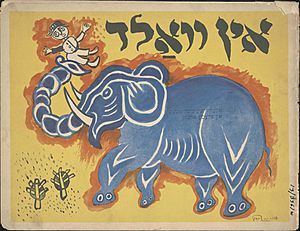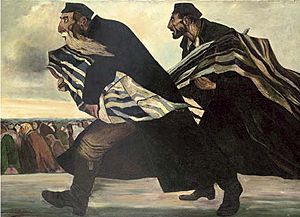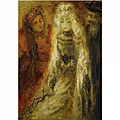Issachar Ber Ryback facts for kids
Issachar Ber Ryback (also spelled Riback) was a talented Ukrainian-French painter. He was born on February 2, 1897, in Yelisavetgrad, Ukraine, which is now called Kropyvnytskyi. Ryback passed away on December 22, 1935, in Paris, France. He is known for his unique art style, which changed over time.
Ryback's Early Life and Art
Issachar Ber Ryback went to art school in Kiev until 1916. While there, he joined a group of artists who wanted to create new and modern art. He was also inspired by writers who were developing modern Jewish literature. Important painters like Alexander Bogomazov and Alexandra Exter taught him in 1913.
In 1916, Ryback and another artist named El Lissitzky were given a special job. They were asked to create art that remembered the Jewish villages, called Shtetls, in Ukraine and Belarus. These villages had a rich history and culture.
In the spring of 1917, Ryback showed his art at an exhibition of Jewish paintings and sculptures in Moscow. His works were highly praised there.
Art and Challenges
During a big historical event called the October Revolution in 1917, Ryback became very active. He worked to help redefine Jewish culture through art. He moved to Moscow for this work.
However, his family faced a terrible tragedy. His father was killed during violent attacks called Pogroms in Ukraine. Because of this danger, Ryback had to leave his home. In April 1921, he fled to Kaunas, and later that year, he got a visa to go to Germany. He lived in Berlin until 1924.
While in Berlin, Ryback joined an art group called the Novembergruppe. He showed his Cubist paintings at famous art shows like the Berliner Secession. Cubism is an art style where artists break down objects into geometric shapes and show them from different angles.
Ryback also illustrated three small Yiddish fairy tale books for children. In 1923, he published a special collection of lithographs called Shtetl. My Destroyed Home. A Memorial. This book showed pictures of his hometown, which had been damaged by the pogroms. He also designed the logo for World ORT, an organization focused on Jewish education.
Moving to Paris
In 1924, Ryback tried to work in the Soviet Union, decorating stages for Yiddish theaters. But in 1926, he moved to Paris, France, and decided not to return to Russia.
In Paris, his art style changed. He began using bright, expressive colors, a style known as Expressionism. This was part of the "School of Paris" art movement during the time between the two World Wars. He had solo art shows in Paris in 1928 and 1929. His art was also shown in galleries in other European cities like The Hague, Rotterdam, Brussels, and Antwerp.
In 1935, he traveled to Cambridge for the opening of one of his exhibitions. Sadly, Issachar Ber Ryback passed away before he could see a special exhibition of all his works, which was organized by Georges Wildenstein in Paris.
Ryback was an important artist of his time, alongside other Jewish-Russian artists like Natan Issajewitsch Altman, Boris Aronson, and Marc Chagall. These artists helped bring Jewish traditions into modern art.
Today, many of Ryback's artworks are kept at the Museum Ryback in Bat Yam, Israel. This museum is part of the MoBY-Museums of Bat Yam complex.
Images for kids































